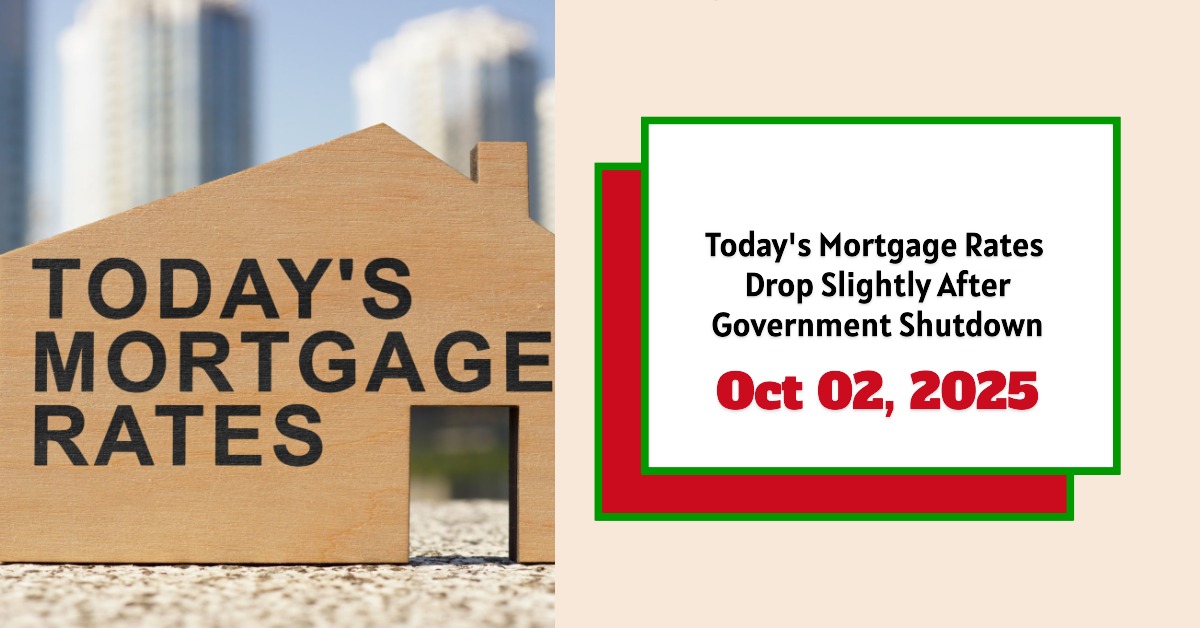As of October 2, 2025, today's mortgage rates have shown a slight drop following the recent US government shutdown. Mortgage rates tend to loosely track the 10-year Treasury yield, which saw a decline on October 1st, 2025. During times of government shutdown and uncertainty, investors often move their money into safer assets like Treasury bonds, which can push Treasury yields lower and consequently affect mortgage rates.
Today's Mortgage Rates – October 2, 2025: Rates Drop Slightly After Government Shutdown
The national average 30-year fixed mortgage rate stands at 6.57%, down slightly by 2 basis points from the previous week’s 6.59%. Meanwhile, refinance rates for the same loan length are at 6.98%, a modest decrease from 7.03% the previous week. Shorter-term rates and adjustable-rate mortgages (ARMs) show small fluctuations this week, reflecting ongoing market uncertainty and inflation concerns.
The big picture: mortgage rates are still elevated but may gradually ease, influenced by the recent Federal Reserve rate cut, economic data, and Treasury yields. This means borrowing costs remain significant, but there could be opportunities for buyers and refinancers as the year progresses.
Key Takeaways
- 30-year fixed mortgage rate is currently at 6.57%, slightly down from 6.59% last week.
- 30-year fixed refinance rate is at 6.98%, showing a minor decline from 7.03%.
- The 15-year fixed mortgage rate has dropped modestly to 5.64%.
- Adjustable-rate mortgages like the 5-year ARM saw an uptick, now at 6.98%.
- The Federal Reserve cut its benchmark rate recently, influencing Treasury yields and gradually easing mortgage borrowing costs.
- Despite the easing trends, the spread between Treasury yields and mortgage rates remains wide, limiting the drop in mortgage rates.
- Experts forecast rates to average around 6.4% in late 2025 and potentially dip near 6.1% in 2026.
- Economic factors such as inflation at 2.9% (above target) and solid GDP growth (3.8% annualized) play a critical role in rate movements.
Current Mortgage Rates on October 2, 2025
To give a clearer picture, here’s a summary of the current mortgage rates by loan type, including their weekly change and APR (Annual Percentage Rate):
| Loan Type | Rate | Weekly Change | APR | APR Weekly Change |
|---|---|---|---|---|
| 30-Year Fixed | 6.57% | Down 0.02% | 6.76% | Down 0.29% |
| 20-Year Fixed | 6.43% | Up 0.07% | 6.94% | Up 0.30% |
| 15-Year Fixed | 5.64% | Down 0.12% | 5.75% | Down 0.32% |
| 10-Year Fixed | 5.84% | No Change | 6.23% | No Change |
| 7-Year ARM | 7.28% | No Change | 7.72% | Down 0.01% |
| 5-Year ARM | 6.98% | Down 0.16% | 7.25% | Down 0.56% |
Government-backed loan rates:
| Loan Type | Rate | Weekly Change | APR | APR Weekly Change |
|---|---|---|---|---|
| 30-Year Fixed FHA | 5.66% | Down 0.15% | 6.67% | Down 0.15% |
| 30-Year Fixed VA | 6.19% | Up 0.12% | 6.41% | Up 0.19% |
| 15-Year Fixed FHA | 5.31% | Down 0.01% | 6.27% | Down 0.01% |
| 15-Year Fixed VA | 5.86% | No change | 6.21% | Up 0.09% |
(Source: Zillow)
Current Refinance Rates: A Mixed Picture
Refinance rates tend to be slightly higher than purchase mortgage rates due to credit profiles and loan terms. Here's a snapshot of refinance rates as of October 2, 2025:
| Loan Type | Rate | Weekly Change |
|---|---|---|
| 30-Year Fixed | 6.98% | Down 0.05% |
| 15-Year Fixed | 5.84% | Up 0.13% |
| 5-Year ARM | 7.35% | Up 0.19% |
While the 30-year fixed refinance rate has edged slightly lower (from 7.03% to 6.98%), the 15-year fixed and 5-year ARM refinance rates increased moderately. This behavior highlights lenders' cautiousness amid economic data and market volatility.
How Mortgage Rate Changes Affect Borrowers
Understanding what these rates mean in practical terms can help clarify their impact:
- For a $300,000 loan on a 30-year fixed rate at 6.57%, the monthly principal and interest payment would be approximately $1,915.
- If the rate drops to 6.50% (a slight reduction), that payment would decrease to around $1,896, saving about $19 per month or $228 annually.
- Refinancing from an older rate of 7.5% to today’s 6.98% on a $300,000 loan would reduce monthly payments from about $2,096 to $1,995, a savings of roughly $101 per month.
Small rate shifts like these can add up over time but emphasize why watching even minor basis point changes is important for borrowers.
Factors Influencing Mortgage Rates Today
1. The Federal Reserve's Rate Cut in September 2025
On September 17, the Federal Reserve trimmed its benchmark interest rate to a range of 4.0% to 4.25%. This was the first rate cut after a long pause and signals a shift toward easing borrowing costs. The Fed remains cautious because:
- Inflation, measured by the core PCE index, is at 2.9%, above the Fed's 2% target.
- Economic growth remains solid at 3.8% annualized.
The Fed’s policy aims to strike a balance between cooling inflation and supporting growth.
2. Treasury Yields and Mortgage Rates
Mortgage rates generally follow the yield on the 10-year U.S. Treasury note, currently at 4.12% — slightly below its long-term average of 4.25%. Mortgages, however, trade at a spread of 1-2 percentage points above Treasury yields to compensate investors for higher risk, and lately, this spread has grown wider, keeping mortgage rates elevated.
3. Economic Indicators and Market Sentiment
- Inflation staying above target keeps the Fed cautious with further rate cuts.
- Strong GDP growth contrasts with a slightly cooling labor market.
- Market volatility increases risk premiums, contributing to wider spreads.
Expert Forecasts for Mortgage Rates
Several leading organizations provide forecasts for the future movement of mortgage rates:
- National Association of REALTORS® predicts average mortgage rates will be about 6.4% in late 2025, falling to approximately 6.1% in 2026. They highlight rates as a “magic bullet” influencing home affordability and market demand.
- Fannie Mae forecasts year-end 2025 rates at 6.4%, dropping to 5.9% in 2026, projecting an increase in refinancing activity due to lower rates.
- Mortgage Bankers Association anticipates rates could hover around 6.7% by the end of 2025, decreasing to 6.5% by the end of 2026 but warns of volatility and wider spreads affecting refinance volumes.
The Spread Between Treasury Yields and Mortgage Rates: Why It Matters
A key technical driver keeping mortgage rates relatively high despite falling Treasury yields is the persistent “spread” between these two. Historically, the spread was about 1 to 1.5 percentage points, but recently it has widened to over 2 points. This impacts the actual rate consumers pay because:
- Investors demand higher yields on mortgage-backed securities for perceived risk.
- Market uncertainty creates premiums that lenders pass on to borrowers.
If this spread narrows in the future, mortgage rates could decrease more sharply, improving affordability substantially.
Related Topics:
Mortgage Rates Trends as of October 1, 2025
Mortgage Rates Predictions Next 90 Days: August to October 2025
Impact on Homebuyers and Homeowners
- Homebuyers face higher borrowing costs but can benefit from modest rate declines if they act at favorable times.
- Homeowners contemplating refinancing have limited but improved opportunities if their current rates exceed 6.5%.
- Sellers might see increased listings as current owners take advantage of slightly lowered rates to move.
- The housing market might see more balanced supply-demand dynamics if falling mortgage rates encourage activity.
Summary Table: Mortgage vs. Refinance Rates (October 2, 2025)
| Loan Program | Mortgage Rate | Change (Weekly) | Refinance Rate | Change (Weekly) |
|---|---|---|---|---|
| 30-Year Fixed | 6.57% | -0.02% | 6.98% | -0.05% |
| 15-Year Fixed | 5.64% | -0.12% | 5.84% | +0.13% |
| 5-Year ARM | 6.98% | -0.16% | 7.35% | +0.19% |
Mortgage rates as of October 2, 2025, are nuanced: though slightly lower than last week's figures, they remain higher than those seen just a few years ago. The interplay of Federal Reserve policy, inflation data, Treasury yields, and market risk premiums ensures that homeowners and buyers must stay informed of the subtle yet impactful fluctuations each week. The forecasts suggest a slow easing but no dramatic drops are imminent, meaning the cost of borrowing for the average American remains significant.
Capitalize Amid Rising Mortgage Rates
With mortgage rates expected to remain high in 2025, it’s more important than ever to focus on strategic real estate investments that offer stability and passive income.
Norada delivers turnkey rental properties in resilient markets—helping you build steady cash flow and protect your wealth from borrowing cost volatility.
HOT NEW LISTINGS JUST ADDED!
Speak with a seasoned Norada investment counselor today (No Obligation):
(800) 611‑3060
Also Read:
- Will Mortgage Rates Go Down in 2025: Morgan Stanley's Forecast
- Mortgage Rate Predictions 2025 from 4 Leading Housing Experts
- Mortgage Rate Predictions for the Next 3 Years: 2026, 2027, 2028
- 30-Year Fixed Mortgage Rate Forecast for the Next 5 Years
- 15-Year Fixed Mortgage Rate Predictions for Next 5 Years: 2025-2029
- Will Mortgage Rates Ever Be 3% Again in the Future?
- Mortgage Rates Predictions for Next 2 Years
- Mortgage Rate Predictions for Next 5 Years
- Mortgage Rate Predictions: Why 2% and 3% Rates are Out of Reach
- How Lower Mortgage Rates Can Save You Thousands?
- How to Get a Low Mortgage Interest Rate?
- Will Mortgage Rates Ever Be 4% Again?



